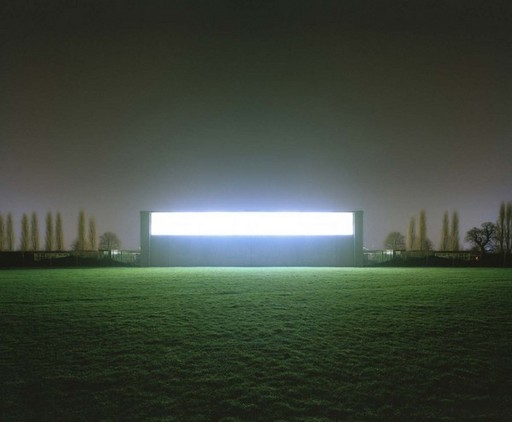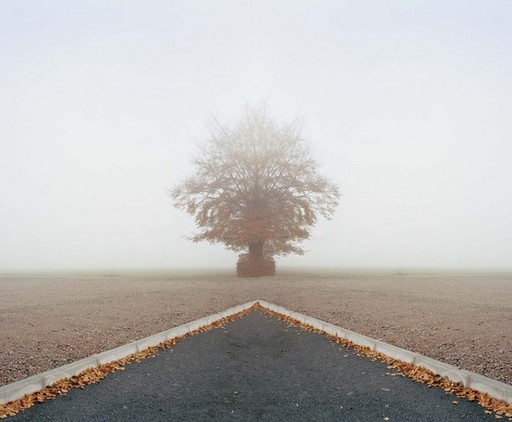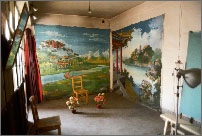July 8, 2009
Edgar Martins
There's quite a kerfuffle brewing about Edgar Martins photoshopping some an image for a story in the NYTimes.
Specifically he mirrored an image to create symmetry and then changed a few things in photoshop to cover his tracks.
This is a story because Martins states emphatically that he does not use photoshop (or other "darkroom manipulations") and because he apparently duped the Times (he should have labeled the picture an editorial illustration rather than editorial photojournalism). I find the whole thing amusing because there are many images Martin's portfolio that are obviously photoshopped using exactly the same technique.
This is easily provable on a suspect image simply by taking half the image, flipping it horizontally and layering it over the other side of the image with say 80% opacity... At that point it's obvious which parts of the image are flipped and which parts are photoshopped in.
Here are two more examples of his work that easily debunk his "no photoshop" proclamation:
For the record, I like Martin's work, and I'm not anti-photoshop (and I'm certainly not anti-darkroom work) but I am anti-hypocrisy.





07/08/09 03:43 PM
Eric said...
Isn't this just lying, not hypocrisy?
07/08/09 04:28 PM
steve said...
I find the whole thing hilarious. You don't even need to replicate these to tell they are PS'd.
If the NY Times image wasn't photoshopped, then maybe someone - an architect perhaps -can explain where those stairs are going and why they run into each other??
And the picture of the tree here is not even close to believable. If it is real, then perhaps Mr. Martins can tell us where there is a street that ends in a bizzare triangular point in the middle of a field. If it existed, it should be visible on Google earth to verify.
Digital art can be cool, but it doesn't belong in editorial photography.
07/08/09 06:30 PM
Anonymous said...
Funny how he tries to hide the photoshopping on the first image with the diagonal in the grass... but the first tree on either side of the billboard and the matching mound of dirt and light behind give way his game. Second picture is just obvious photoshoppery.
I know Martins from that series of beach scenes with the black skies and remember being impressed that it had all been done in camera (or so he had claimed). http://www.capricehorn.com/index.php?aw_id=683&node=artwork2&lang=en The thing about something like this is I now can't take him for his word and his appeal is diminished. If his work had just been labeled properly, I wouldn't have had any doubts.
07/09/09 04:30 AM
ana said...
An Editor's note on the NYTimes website now stands where the photoessay was.
"A reader, however, discovered on close examination that one of the pictures was digitally altered, apparently for aesthetic reasons. Editors later confronted the photographer and determined that most of the images did not wholly reflect the reality they purported to show. Had the editors known that the photographs had been digitally manipulated, they would not have published the picture essay, which has been removed from NYTimes.com."
07/09/09 11:48 AM
jackb said...
it's funny, even aperture was fooled....
http://www.aperture.org/edgar-martins-topologies.html
read the book description
07/09/09 01:22 PM
Shutterbug said...
I want to hear from Edgar. Wonder when he's going to publicly explain himself. He better act fast or else he's career as a "photojournalist" will be over.
07/09/09 01:47 PM
-bob- said...
Though I too am saddened by this fraud, I believe that 99.9% of the population won't care about this issue. People see what the want to see.
I'm sure the "artist" will get way more work now than ever before. Celebrity breeds celebrity.
07/09/09 02:20 PM
Darshan said...
All would be okay if he wouldn't have claimed that they weren't digitally manipulated.
07/12/09 10:34 AM
Shutterfly said...
As a phojo, I made certain rules for myself when I began using digital years ago with the DCS200-- not do anything that couldn't be done traditionally with lenses, filters, or in the darkroom. If I did any other manipulation, I labeled it as manipulated for illustration purposes.
There are differences between photojournalism, photography, and art photography. When manipulation goes beyond the phojo boundry, to me, it becomes art photography and should be labeled as such as the purpose of the image changes.
The images probably would have been fine if he had simply labeled them as manipulated for illustrative purposes.
The line is something that still needs to be addressed as an ethical issue in journalism and photojournalism schools. I can't speak for everyone, but it has been my experience that the issue is more clear to those of us that began our careers using film and a darkroom.
07/12/09 02:35 PM
edgar's plugin said...
Ouch. Must suck to be Martins now.
RIP his career in phojo.
07/12/09 07:28 PM
Anonymous said...
Things Magazine linked to this page and said Photoshop is the "steroids of photojournalism", it's important to note that the 2 pictures linked are being displayed in a fine art context. Martins is not known as a photojournalist but as an artist.
Of course he made a made a huge mistake in duping the Times and will suffer the consequences professionally.
Photojournalists should be held to certain standards and should be barred from actively adding or subtracting elements but it's important to note that Photoshop is just a tool in the workflow just as the camera is a tool. Many of the things that photographers use photoshop for daily are equivalents of simple dodges or burns or crops or color correction that would have traditionally been done in the darkroom and have always been done both in fine art photography and photojournalism. The photoshop "tricks" are the equivalent of darkroom tricks that have been used by less scrupulous photographers since the beginning of photojournalism.
There is no such thing as an objective photo. The photographer points his camera he makes a choice. If he uses film he makes a choice, he makes a choice with shutter speed and aperture selection etc. When shooting RAW files he has a file that contains more information than can be seen and he needs to choose which fraction of that info will be displayed.
It's important not to demonize photoshop, but rather the photographer who deceived his editors and tried to deceive the public.
07/16/09 12:35 PM
anon said...
"it's important to note that the 2 pictures linked are being displayed in a fine art context."
No, it isn't. Throughout his fine art career, he has lied about not using digital manipulation in his photos.
10/25/09 12:48 PM
John F said...
Several years ago, on another photography netsite, I made the huge error of pointing out that many "chosen" images that were singled out as being excellent were really badly photoshopped duds, and that with the right software, or simply mangling the gamma curve, the manipulations would become evident. This caused a bit of hate mail to come my way, a lot of it from supposed photographic experts and gurus with their own netsites showing their expertise. I have always found the images from Martins as appearing manipulated from the very beginning. The fact that he was able to fool so many people for so long shows the lack of expertise many galleries and "photo experts" have with newer technologies, and the tendency to accept many photographers for what they are, based on their own exalted bios and list of accomplishments is a traditional "gallery trap" that is still common.